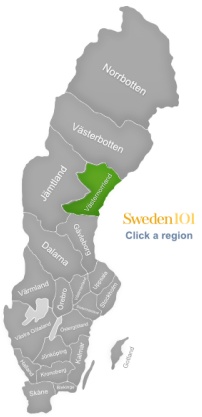Västernorrland - The High Coast, Skule Mountain, Skuleskogen National Park, Sundsvall, Härnösand, Kramfors

What does the name of the region mean?
Västernorrland can be translated as the Western North land. When you look at the location of Västernorrland on the map, you might find the Western part of the name a bit odd, because Västernorrland is actually in Sweden's East, but the Western part was simply used to describe the region's different location in comparison with other regions in Norrland.
What is the region known for?
The region is one of the fastest growing tourism regions within Sweden, mainly because of people's interest in the High Coast, a region that is still rising about a centimeter each year because of the post-glacial rebound.
What are some places you need to visit in Västernorrland?
The High Coast
The High Coast of Västernorrland is a UNESO World heritage site, and interesting for scientists (who examine the post-glacial rebound) as well as for visitors. The land on this stretch of land basically rises because it becomes lighter as the glaciers melt away. For scientists it is a great place to experience the change of the world and examine it, and for visitors it's simply a spectacular place to see – but of course, they will also be able to learn more about the science behind the constant changes in this landscape.
Skule Mountain
Skule Mountain in the Skule Mountain National Park is a lovely mountain to explore and hike up to. The steps that are used to climb up the mountain make it possible for non-climbers to get up there, too. But you need to be quite fit, and also go there at the right time of the year.
Skuleskogen National Park
The Skuleskogen National Park is an alternative to climbing the mountain though some of the tracks also require you to be reasonably fit. There are many rocky peaks, crevasses and also caves that might be interesting to explore. There are some sites of historical interest in the park like some ancient cairns, but people have never truly established themselves in that region of Sweden, and even today this national park is quite remote and it takes a while to get back to proper civilization. It is not completely devoid of people though as it is a very popular park for visitors. In the past, there have been smaller settlements in the forests, but there has never been any kind of settlement in the area of today's national park, so this place is your chance to visit a very unspoilt area.
Sundsvall
Sundsvall is the largest city of the region and its capital. In 1888, the whole city was destroyed by a fire, and after that, the buildings have been built by using stones as materials to avoid a similar catastrophe in the future. The old stone houses from around 1890 can still be seen in the old city area. There are some interesting museums in Sundsvall in which you can learn more about the history and culture of the city and the region.
Härnösand
While the town itself isn't that exciting, there is a nice cathedral and a good museum about the county. The town is easily accessible by train and worth a day-trip.
Kramfors
This town is a good choice if you would like to explore the High Coast. Historically speaking, the town has lost some of its former importance from the days when it used to be the center of the lumber and pulp industry during the 19th century.

_(2).jpg)